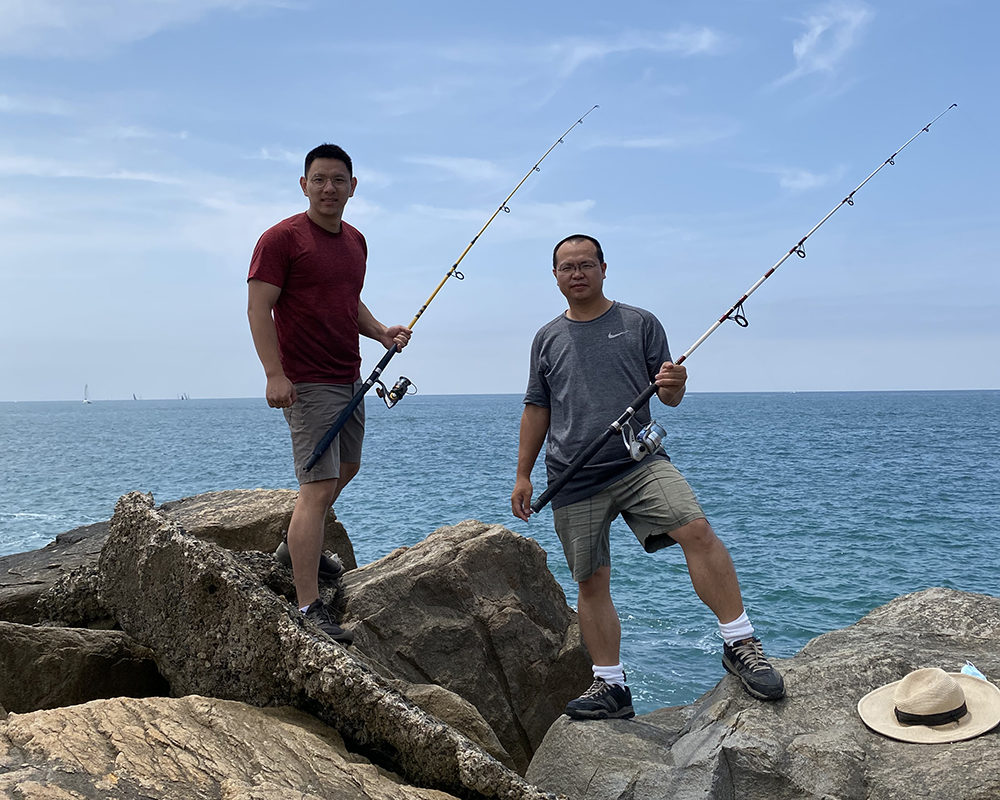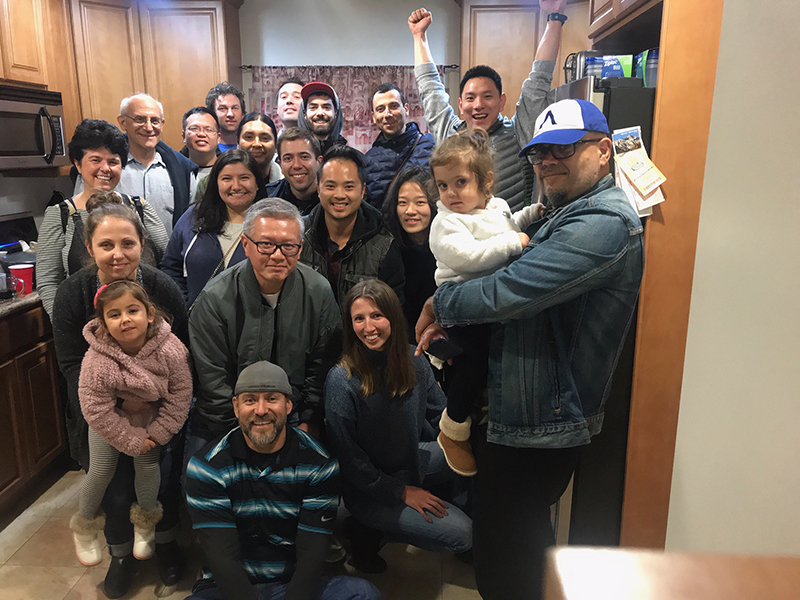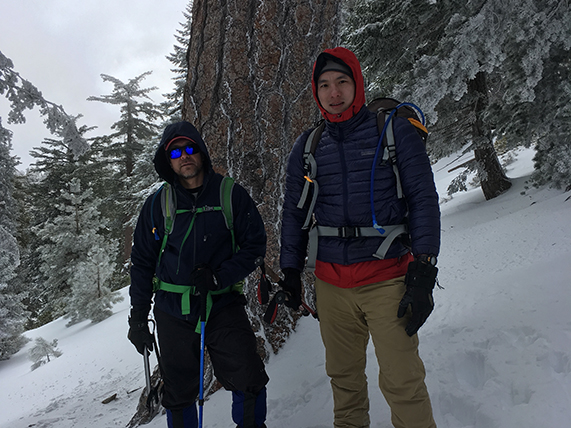
Scientists Litao Tao and Haoze (Vincent) Yu were colleagues and team players for many years both inside and outside of Neil Segil’s lab at the Eli and Edythe Broad CIRM Center for Regenerative Medicine and Stem Cell Research at USC. In the lab, they succeeded in making new discoveries about the development of the sensory cells of the inner ear. Meanwhile, on the basketball court, they led their team to victory on many occasions, and also challenged each other during spirited one-on-one matches.
“When we played one-on-one basketball, I was physically stronger,” said Yu, who graduated with his PhD in development, stem cells, and regenerative medicine from USC. “But Litao had the better skillset. Together, we made a great team.”
“Our teamwork also carried over into the research lab,” said Tao, who earned his PhD in genetics, molecular, and cellular biology and completed his postdoctoral training at USC.
Tao grew up in the city of Chongqing in southwest China, and earned his bachelor’s and master’s degrees in biology at Tsinghua University in Beijing. While pursuing his PhD at USC, Tao joined the Segil Lab to study the inner ear.
“The inner ear is like an art piece,” said Tao. “There are multiple cell types, and the sensory cells and the supporting cells interdigitate each other. So I was very interested in how this beautiful organ develops that way.”
While completing his PhD dissertation, Tao began learning more about computational analysis and bioinformatics. He then decided to continue working in the Segil Lab and dedicate his postdoctoral training to next-generation genome sequencing, a new technology for analyzing massive amounts of genetic material to identify variations associated with hearing loss and other diseases.
Tao thrived under the guidance of Segil, who was recently awarded a USC Mentoring Award for fostering an engaging, supportive and inclusive academic environment.
“Neil always encourages his students and postdocs to try new ideas,” said Tao. “If you have a new idea, no matter how baseless it is, you can always talk to him. He will think through it with you, talk about it, and say what the pitfalls and the outcomes might be. And the way he manages the lab, he likes people to be more self-motivated and doesn’t push people for results. So that’s probably the reason why everyone in the Segil Lab is nice, because they don’t feel pressure from him, so they relax and enjoy the research.”

Throughout his years in the Segil Lab, Tao enjoyed one particularly productive way to relax while thinking through complex scientific problems: going fishing.
“When I was in LA, I went fishing almost every weekend,” he said. “I’d cast the baits out, and then I’d sit there. While I was watching for the signals, I could think about work in a low-pressure way. So I’d think of a lot of experiments, or figure out what a problem was. Sometimes you have to jump out of the regular environment, and then you can get new ideas.”
Segil also introduced Tao to Yu, who became a close collaborator and friend. Yu also began his scientific career in China, where he grew up in the northern coastal city of Qingdao. His parents ran a container shipping company, and encouraged Yu to become the first member of their family to earn a college degree.
Yu entered Qingdao’s Ocean University of China as an ecology major. After working in a lab that studied cornea transplants, Yu switched to biology for both his bachelor’s and master’s degrees. He began deriving stem cells from the cornea, and realized that he wanted to continue pursuing biomedical research.
Yu was accepted into the PhD program at USC and joined the Segil Lab, where he learned how the inner ear forms during embryonic development.
Yu also learned a few life lessons along the way.
“Neil didn’t only teach me about the things that we were working on,” said Yu. “He has such great experience as a person. In the early years, he worked in factories, making travel trailers in Salt Lake City. In high school, he traveled to Newfoundland. He tells me a lot of stories about his experience and his friends’ experience. It’s not just academic things.”
Like Tao, Yu was struck by how Segil encouraged him to tap into his own motivation and independence.
“I asked Neil if I could take a break from the lab for a week to go on a hiking trip,” said Yu. “He told me that I’m responsible for my own life, and that I should pursue my own interests and do what I want to do. That’s an attitude I didn’t have growing up in China. But Neil made me realize that from now on, I should be responsible for my own time, my career, and my life. So I went on that trip.”

Yu completed 75 miles of the John Muir Trail stretching from Mammoth Mountain to Yosemite National Park, and summited the tallest mountain in the continental U.S., Mount Whitney.
Yu and Tao also followed Segil’s advice about pursuing their passions in the scientific realm, and served as co-first authors on two studies published in 2021. The first, which appeared in the Proceedings of the National Academy of the Sciences (PNAS), described similarities in the development of two types of sensory cells: the ones that receive sound vibrations in the inner ear, and the ones that sense light touch at the surface of the skin. The second, featured in Developmental Cell, identified a natural barrier to the regeneration of the sensory cells in the inner ear.
Yu also collaborated with scientists from other laboratories in the Department of Stem Cell Biology and Regenerative Medicine. Working with postdoc Katie Galloway from the laboratory of Justin Ichida, Yu explored gene regulation in patients with amyotrophic lateral sclerosis (ALS), also known as Lou Gehrig’s disease, with support from a Doerr Stem Cell Challenge Grant. In 2021, Yu and postdoc Pengfei Xu from the laboratory of Gage Crump co-authored an eLife study about craniofacial development in zebrafish.
Now, Yu and Tao are building on these successes during the next stages of their careers.
After earning his PhD at USC in 2020, Yu completed postdoctoral training in the laboratory of Xin Sun at the University of California, San Diego, where he used computational and bioinformatics approaches to understand lung development in pre-term infants. He is now applying similar approaches to developing stem cell-derived immunotherapies for blood cancers and solid tumors as a scientist at Fate Therapeutics in San Diego.
In 2021, Tao left the Segil Lab to accept a tenure track assistant professor position at Creighton University, studying the biology of the inner ear with a goal of developing new treatments for hearing loss.
However, the two will remain Segil Lab alumni for life.
“There are still projects going on as a collaboration between my new lab and Neil’s lab, so we talk a lot,” said Tao. “Actually, we have a group chat channel with everyone in the Segil Lab. So when someone’s birthday is coming, we say happy birthday to each other. Last week, when I caught a big fish, I sent a picture to everyone.”
Yu added: “Working in the Segil Lab is like a family. He’s like a parent to me. I love him so much, and I made a really important right decision in joining the Segil Lab as a graduate student.”
